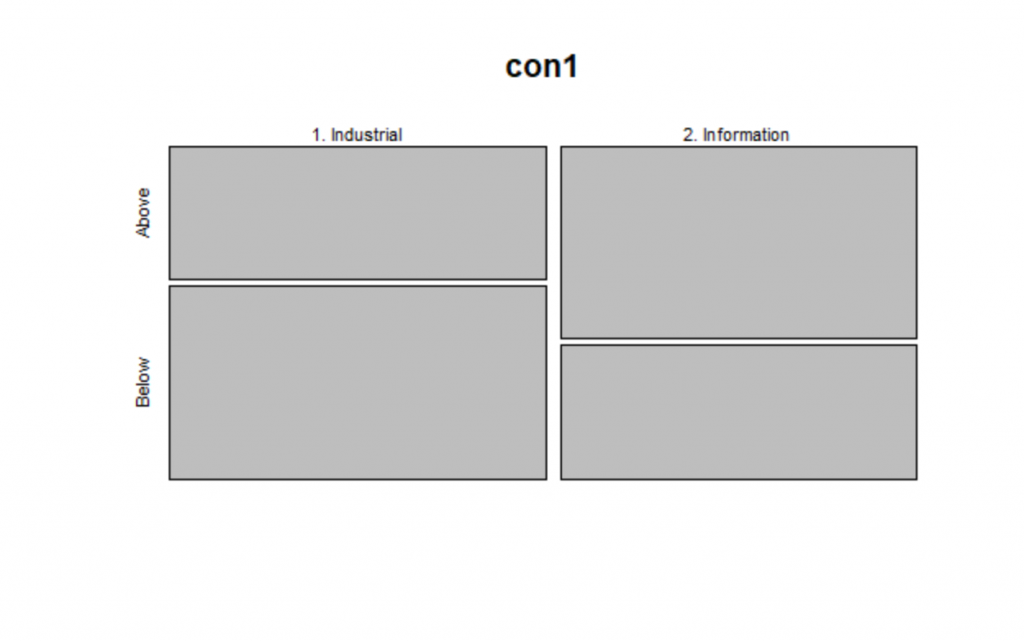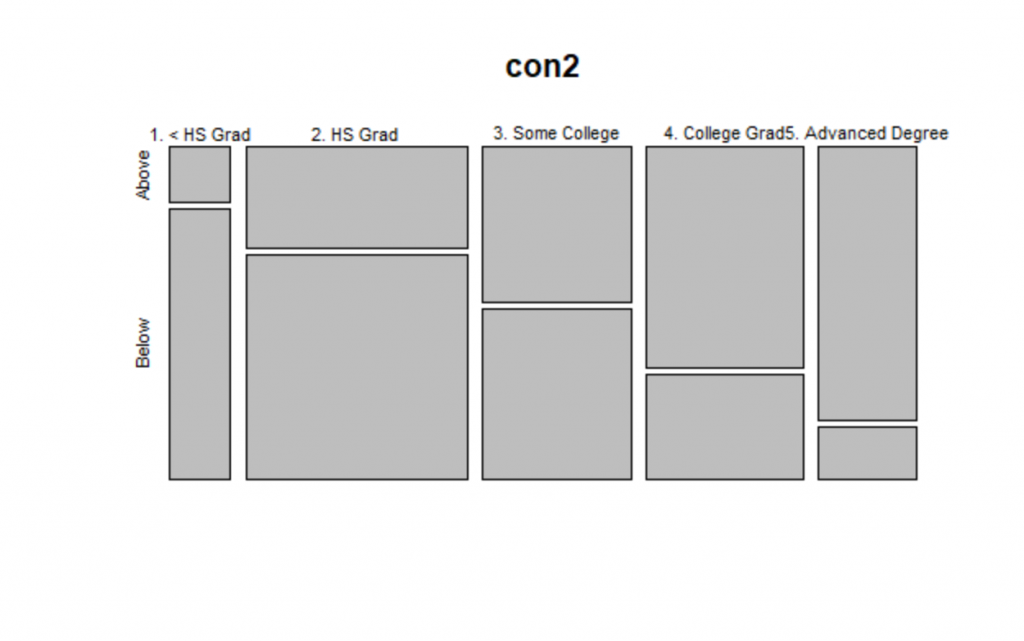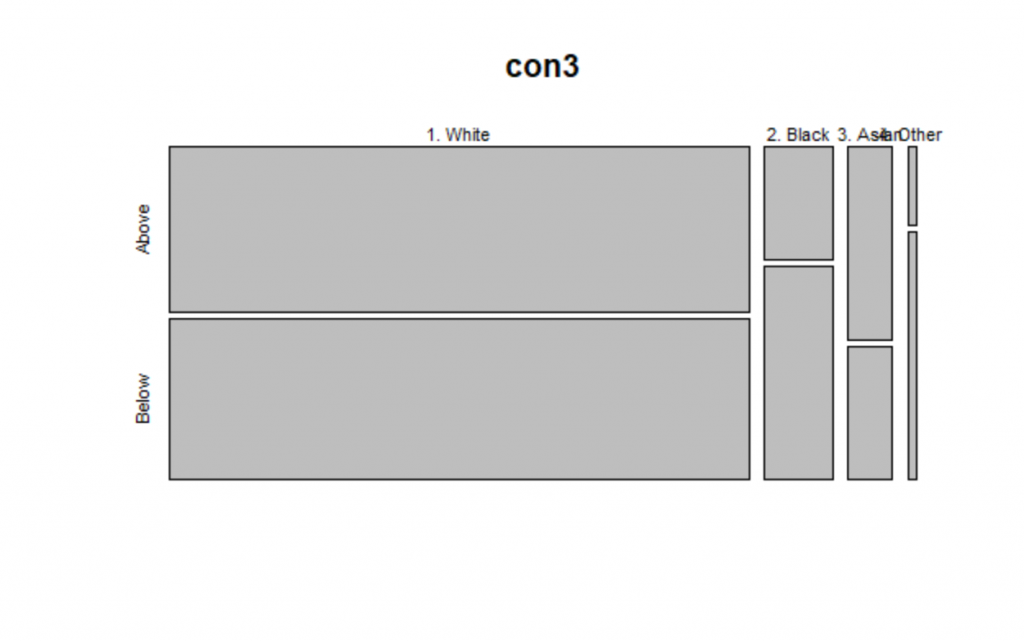A common way to represent and analyze categorical data is through contingency tables. In this tutorial, we will provide some examples of how you can analyze two-way (r x c) and three-way (r x c x k) contingency tables in R.
Dataset
For this tutorial, we will work with the Wage dataset from the ISLR package. We will create another column of the Wage, which is categorical taking two values as Above and Below when the Wage is above or below media respectively. The format of the dataset is the following:
A data frame with 3000 observations on the following 11 variables.
- year: Year that wage information was recorded
- age: Age of worker
- marit1: A factor with levels
1. Never Married2. Married3. Widowed4. Divorcedand5. Separatedindicating marital status - race: A factor with levels
1. White2. Black3. Asianand4. Otherindicating race - education: A factor with levels
1. < HS Grad2. HS Grad3. Some College4. College Gradand5. Advanced Degreeindicating education level - region: Region of the country (mid-atlantic only)
- jobclass: A factor with levels
1. Industrialand2. Informationindicating type of job - health: A factor with levels
1. <=Goodand2. >=Very Goodindicating health level of worker - health_ins: A factor with levels
1. Yesand2. Noindicating whether worker has health insurance - logwage: Log of workers wage
- wage: Workers raw wage
Two-Way Tables
Two-way tables involve two categorical variables, X with r categories and Y with c. Therefore, there are r times c possible combinations. Sometimes, both X and Y will be response variables, in which case it makes sense to talk about their joint distribution. On other occasions, Y will be the response variable and X will be the explanatory variable. In this case, it does not make sense to talk about the joint distribution of X and Y. Instead, we focus on the conditional distribution of Y given X.
Let’s start analyzing the data. At the beginning we can see the relationship between wage_cat and Jobclass.
library(ISLR) library(tidyverse) library(Rfast) library(MASS) # create the wage_cat variable which takes two values # such as Above if the wage is above median and Below if # the wage is below median Wage$wage_cat<-as.factor(ifelse(Wage$wage>median(Wage$wage),"Above","Below")) # Examine the Wage vs Job Class # you could use also the command xtabs(~jobclass+wage_cat, data=Wage) con1<-table(Wage$jobclass,Wage$wage_cat) con1
Output:
Above Below
1. Industrial 629 915
2. Information 854 602Mosaic plots
The most proper way to represent graphically the contingency tables are the mosaic plots:
mosaicplot(con1)

From the mosaic plot above we can easily see that in the Industrial sector the percentage of people who are below the median are more compared to those who work in the Information industry.
Proportions of the Contingency Tables
We can get the proportions of the Contingency Tables, on overall and by rows and columns. Let’s see how we can do it:
# overall prop.table(con1) # by row prop.table(con1, margin = 1) # by column prop.table(con1, margin = 2)
Output:
> # overall
> prop.table(con1)
Above Below
1. Industrial 0.2096667 0.3050000
2. Information 0.2846667 0.2006667
>
> # by row
> prop.table(con1, margin = 1)
Above Below
1. Industrial 0.4073834 0.5926166
2. Information 0.5865385 0.4134615
>
> # by column
> prop.table(con1, margin = 2)
Above Below
1. Industrial 0.4241403 0.6031641
2. Information 0.5758597 0.3968359Rows and Columns Totals
We can add the rows and columns totals of the contingency tables as follows:
addmargins(con1)
Output:
Above Below Sum
1. Industrial 629 915 1544
2. Information 854 602 1456
Sum 1483 1517 3000Statistical Tests
We can apply the following statistical tests in order to test if the relationship of these two variables is independent or not.
Chi-Square Test
We have explained the Chi-Square Test in a previous post. Let’s run it in R:
chisq.test(con1)
Output:
Pearson's Chi-squared test with Yates' continuity correction data: con1 X-squared = 95.504, df = 1, p-value < 2.2e-16
As we can see the p-value is less than 5% thus we can reject the null hypothesis that the jobclass is independent to median wage.
Fisher’s Exact Test
When the sample size is low, we can apply the Fisher’s exact test instead of Chi-Square test.
fisher.test(con1)
Output:
Fisher's Exact Test for Count Data
data: con1
p-value < 2.2e-16
alternative hypothesis: true odds ratio is not equal to 1
95 percent confidence interval:
0.4177850 0.5620273
sample estimates:
odds ratio
0.4847009 Again, we see that we reject the null hypothesis.
Log Likelihood Ratio
Another test that we can apply is the Log Likelihood Ratio using the MASS package:
loglm( ~ 1 + 2, data = con1)
Output:
Call:
loglm(formula = ~1 + 2, data = con1)
Statistics:
X^2 df P(> X^2)
Likelihood Ratio 96.73432 1 0
Pearson 96.21909 1 0Again, we rejected the null hypothesis.
Notice that if we run the same analysis by comparing the wage median versus race and the wage median vs education, we find tha there is a statistical significance difference in both cases.
con2<-table(Wage$education,Wage$wage_cat) con2 mosaicplot(con2) chisq.test(con2) con3<-table(Wage$race,Wage$wage_cat) con3 mosaicplot(con3) chisq.test(con3)
Output


Three-Way Tables
Let’s say that now we want to create contingency tables of three dimensions such as wage median, race and jobclass
con4<-xtabs(~jobclass+wage_cat+race, data=Wage) ftable(con4)
Output:
race 1. White 2. Black 3. Asian 4. Other
jobclass wage_cat
1. Industrial Above 558 32 36 3
Below 767 79 50 19
2. Information Above 701 70 77 6
Below 454 112 27 9Let’s say that we want to change the share of the rows and columns.
con4%>%ftable(row.vars=c("race", "jobclass"))
Output:
wage_cat Above Below
race jobclass
1. White 1. Industrial 558 767
2. Information 701 454
2. Black 1. Industrial 32 79
2. Information 70 112
3. Asian 1. Industrial 36 50
2. Information 77 27
4. Other 1. Industrial 3 19
2. Information 6 9Let’s say now we want to get the probabilities by row:
con4%>%ftable(row.vars=c("race", "jobclass"))%>%prop.table(margin = 1)%>%round(2)
Output:
wage_cat Above Below
race jobclass
1. White 1. Industrial 0.42 0.58
2. Information 0.61 0.39
2. Black 1. Industrial 0.29 0.71
2. Information 0.38 0.62
3. Asian 1. Industrial 0.42 0.58
2. Information 0.74 0.26
4. Other 1. Industrial 0.14 0.86
2. Information 0.40 0.60Cochran-Mantel-Haenszel (CMH) Methods
We are dealing with a 2x2x4 table where the race has 4 levels. We want to test for conditional independence and homogeneous associations with the K conditional odds ratios in 2x2x4 table. With the CMH Methods, we can combine the sample odds ratios from the 4 partial tables into a single summary measure of partial association. In our case, we have the wage_cat (Above, Below) the jobclass (Industrial, Information) and the race (White, Black, Asian, Other). We want to investigate the association between wage_cat and jobclass while controlling for race.
The null hypothesis is that wage_cat and jobclass are conditionally independent, given the race, which means that the odds ratio of wage_cat and jobckass is 1 for all races versus at least one odds ratio is not 1.
\(H_0: θ=1\) for race is White, Black, Asian and Other.
Using the Rfast package we can get the odds ratio for each race:
#get the 4 odds ratio
for (i in 1:4) {
print(odds.ratio(con4[,,i])$res[1])
}
Output:
odds ratio
0.471169
odds ratio
0.6481013
odds ratio
0.2524675
odds ratio
0.2368421 As we can see, the odds ratios are not close to 1, so we expect to reject the null hypothesis. Let’s run the CHM test:
#CMH Test mantelhaen.test(con4)
Output:
Mantel-Haenszel chi-squared test with continuity correction
data: con4
Mantel-Haenszel X-squared = 104.45, df = 1, p-value < 2.2e-16
alternative hypothesis: true common odds ratio is not equal to 1
95 percent confidence interval:
0.4003835 0.5381067
sample estimates:
common odds ratio
0.4641649 As expected, we rejected the null hypothesis since the p-value is less than 5%.
Conclusion
The contingency tables is the best way to represent and analyze the relationship between categorical variables. The Cochran-Mantel-Haenszel is the proper test for 2x2xk tables and is a good approach when we are dealing with cases that have the Simpson’s Paradox.




1 thought on “Contingency Tables in R”
Nice post with interesting results. One problem only – how to install Rfast package:
Warning messages:
1: In utils::install.packages(“RcppZiggurat”, repos = “https://cloud.r-project.org”) :
installation of package ‘RcppGSL’ had non-zero exit status
2: In utils::install.packages(“RcppZiggurat”, repos = “https://cloud.r-project.org”) :
installation of package ‘RcppZiggurat’ had non-zero exit status
3: In utils::install.packages(“Rfast”, repos = “https://cloud.r-project.org”) :
installation of package ‘RcppGSL’ had non-zero exit status
4: In utils::install.packages(“Rfast”, repos = “https://cloud.r-project.org”) :
installation of package ‘RcppZiggurat’ had non-zero exit status
5: In utils::install.packages(“Rfast”, repos = “https://cloud.r-project.org”) :
installation of package ‘Rfast’ had non-zero exit status